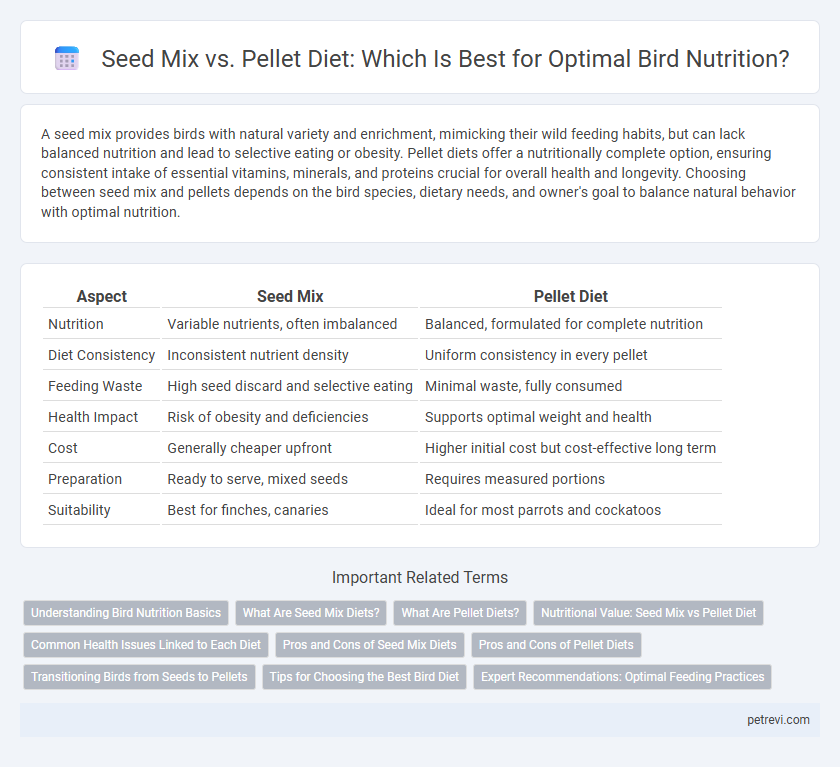A seed mix provides birds with natural variety and enrichment, mimicking their wild feeding habits, but can lack balanced nutrition and lead to selective eating or obesity. Pellet diets offer a nutritionally complete option, ensuring consistent intake of essential vitamins, minerals, and proteins crucial for overall health and longevity. Choosing between seed mix and pellets depends on the bird species, dietary needs, and owner's goal to balance natural behavior with optimal nutrition.
Table of Comparison
| Aspect | Seed Mix | Pellet Diet |
|---|---|---|
| Nutrition | Variable nutrients, often imbalanced | Balanced, formulated for complete nutrition |
| Diet Consistency | Inconsistent nutrient density | Uniform consistency in every pellet |
| Feeding Waste | High seed discard and selective eating | Minimal waste, fully consumed |
| Health Impact | Risk of obesity and deficiencies | Supports optimal weight and health |
| Cost | Generally cheaper upfront | Higher initial cost but cost-effective long term |
| Preparation | Ready to serve, mixed seeds | Requires measured portions |
| Suitability | Best for finches, canaries | Ideal for most parrots and cockatoos |
Understanding Bird Nutrition Basics
Seed mix diets provide birds with a variety of natural nutrients, including essential fats, proteins, and fiber, but can be inconsistent in delivering balanced vitamins and minerals. Pellet diets are scientifically formulated to meet the complete nutritional needs of birds, offering controlled portions of proteins, fats, vitamins, and minerals for optimal health. Understanding bird nutrition basics involves recognizing that a balanced diet combining both seed mixes and pellets can support diverse dietary requirements and prevent nutritional deficiencies.
What Are Seed Mix Diets?
Seed mix diets for birds consist of a variety of seeds such as millet, sunflower, safflower, and flax, providing essential nutrients like protein, fat, and fiber. These diets mimic natural foraging behavior and offer birds diverse textures and flavors that encourage feeding. However, seed mixes often lack complete vitamins and minerals, necessitating supplementation for balanced nutrition.
What Are Pellet Diets?
Pellet diets for birds consist of compressed, nutritionally balanced ingredients designed to provide essential vitamins, minerals, proteins, and fats in every bite. These pellets reduce selective eating behaviors common in seed mixes by ensuring consistent nutrient intake. Formulated to support optimal avian health, pellet diets help prevent nutritional deficiencies and promote overall well-being.
Nutritional Value: Seed Mix vs Pellet Diet
Seed mixes often provide a variety of textures and flavors but can lack essential vitamins and minerals, leading to nutritional imbalances in birds. Pellet diets are formulated to deliver a balanced combination of proteins, fats, carbohydrates, vitamins, and minerals, ensuring consistent nutritional intake. Studies show birds fed pellet diets exhibit improved plumage, weight maintenance, and overall health compared to those on seed-only diets.
Common Health Issues Linked to Each Diet
Seed mix diets often lead to nutritional imbalances in birds, contributing to obesity, fatty liver disease, and vitamin deficiencies such as hypovitaminosis A. Pellet diets provide more balanced nutrients, reducing the risk of malnutrition-related problems but can sometimes cause selective eating or reduced dietary variety if not properly formulated. Both diets require careful monitoring to prevent common health issues like digestive disturbances and ensure optimal bird nutrition.
Pros and Cons of Seed Mix Diets
Seed mix diets offer birds a variety of flavors and textures, promoting foraging behavior that supports mental stimulation and natural instincts. However, seed mixes can be high in fat and low in essential nutrients such as vitamins A, D, and calcium, potentially leading to nutritional imbalances and obesity. The inconsistent nutritional content in seed mixes compared to pellets may require supplementation to ensure optimal bird health and longevity.
Pros and Cons of Pellet Diets
Pellet diets for birds offer consistent nutrition by providing balanced vitamins, minerals, and proteins essential for avian health, reducing selective feeding and minimizing waste compared to seed mixes. However, pellets can lack variety and enrichment, potentially leading to boredom and reduced natural foraging behavior in birds. Some birds may also initially reject pellets due to texture or flavor preferences, requiring gradual diet transitions to ensure acceptance.
Transitioning Birds from Seeds to Pellets
Transitioning birds from a seed mix to a pellet diet enhances balanced nutrition by providing consistent levels of essential vitamins, minerals, and proteins. Gradual introduction over several weeks helps birds adapt to the new texture and taste, reducing stress and preventing dietary rejection. Monitoring intake and consulting avian veterinarians ensures optimal health outcomes during the dietary shift.
Tips for Choosing the Best Bird Diet
Selecting the best bird diet involves evaluating nutrient content, ingredient quality, and the bird's species-specific needs. Seed mixes provide variety and mimic natural foraging but may lack balanced nutrition, while pellet diets offer controlled nutrients and prevent selective feeding. Observing your bird's health, consulting avian veterinarians, and gradually introducing dietary changes ensures optimal nutrition and wellbeing.
Expert Recommendations: Optimal Feeding Practices
Expert recommendations highlight that a seed mix diet often lacks essential vitamins and minerals required for balanced bird nutrition, leading to potential deficiencies. Pellet diets are formulated to provide comprehensive nutrients, ensuring consistent intake of proteins, fats, and micronutrients vital for avian health. Optimal feeding practices suggest incorporating pellets as a primary food source, supplemented with fresh fruits, vegetables, and occasional seeds to promote well-rounded dietary intake.
Seed Mix vs Pellet Diet for Bird Nutrition Infographic

 petrevi.com
petrevi.com